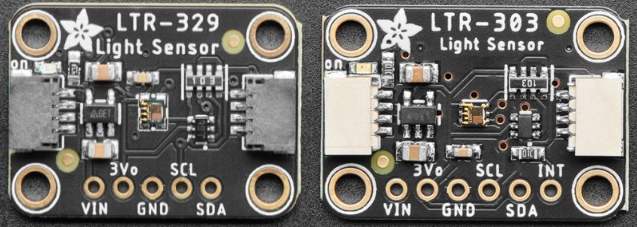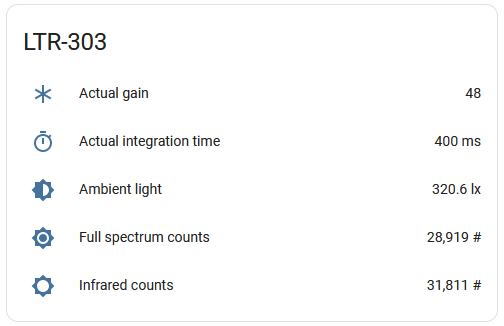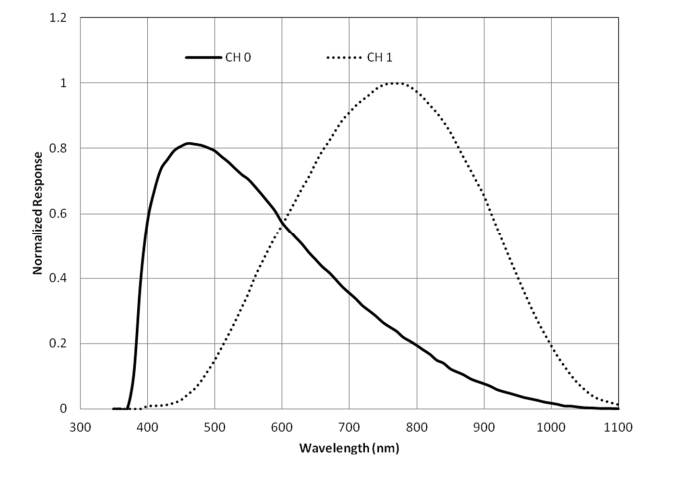Lite-On Ambient Light & Proximity Sensors


The ltr_als_ps sensor platform allows you to use a range of LiteOn ambient light and proximity sensors
with ESPHome. The I²C Bus is required to be set up in your configuration for this sensor to work.
The family of sensors includes:
- Ambient Light Sensors LTR-303ALS and LTR-329ALS
- Integrated Ambient Light and Proximity Sensors LTR-553ALS, LTR-556ALS, LTR-559ALS
- Proximity Sensor LTR-659ALS (with PS gain control)
The sensors are very similar and share the same datasheet. First two have default I²C address 0x29 and the rest
have default I²C address 0x23. The sensors are available on breakout boards from a number of vendors, for
example Adafruit_ or Pimoroni_.
Proximity sensors are the same sort of sensors that you find in phones and tablets to disable the screen when you hold the device up to your ear. They might be useful for automated turning on or off of displays and control panels. An example is the CoreS3 board from M5Stack that has an LTR-559ALS sensor integrated just under the screen.
Ambient light sensing
The sensor platform provides a linear response over a wide dynamic range from 0.01 lux to 64k lux and is well suited to applications under high ambient brightness. There are altogether six gain settings (1X, 2X, 4X, 8X, 48X and 96X) available for user to configure. Use higher gain for dimmer areas.
The devices consist of two photodiodes: The CH0 diode is sensitive to both visible and infrared light and the CH1 diode is sensitive only to infrared light.

Ambient light illuminance calculation
Excerpt from the datasheet:
RATIO = CH1/(CH0+CH1)
IF (RATIO < 0.45)
ALS_LUX = (1.7743 * CH0 + 1.1059 * CH1) / ALS_GAIN / ALS_INT
ELSEIF (RATIO < 0.64 && RATIO >= 0.45)
ALS_LUX = (4.2785 * CH0 – 1.9548 * CH1) / ALS_GAIN / ALS_INT
ELSEIF (RATIO < 0.85 && RATIO >= 0.64)
ALS_LUX = (0.5926 * CH0 + 0.1185 * CH1) / ALS_GAIN / ALS_INT
ELSE
ALS_LUX = 0
ENDwhere:
CH0andCH1are the sensor values (measurement counts) for Visible + IR (Ch0) and IR only (Ch1) sensors respectively.ALS_GAINis the gain multiplierALS_INTis the integration time in ms/100
ALS Gain levels
The table lists gain values and corresponding illuminance range:
| Gain | Illuminance range |
|---|---|
1X 1 | lux to 64k lux (default) |
2X 0. | 5 lux to 32k lux |
4X 0. | 25 lux to 16k lux |
8X 0. | 125 lux to 8k lux |
48X 0. | 02 lux to 1.3k lux |
96X 0. | 01 lux to 600 lux |
This Wikipedia article has a table of some lux values for comparison.
Proximity sensing
The proximity sensor has a built-in emitter and detector. The sensor detects reflected IR light from the emitter and gives a raw count value inversely exponential to the distance. A decrease in the count value means an object is getting further away from the sensor, and vice-versa. Neither of the datasheets provides any information on how to convert the raw count value to distance. The only way to do it is to test the sensor yourself and select the threshold according to your needs and environment. Exact numbers will depend on the type of the object, its color and reflectivity.
Example configuration
sensor:
- platform: ltr_als_ps
address: 0x23
update_interval: 60s
type: ALS_PS # or ALS or PS
ambient_light: "Ambient light"
# PS only section
ps_cooldown: 5 s
ps_high_threshold: 500
on_ps_high_threshold:
then:
- .... # do something - light up the screen for example
ps_counts: "Proximity counts"Configuration variables:
- id (Optional, ID): Manually specify the ID used for code generation.
- address (Optional, int): Manually specify the I²C address of the sensor. Default is
0x29. - type (Optional, string): The type of the sensor. Valid values are
ALS_PS(default) for integrated sensors,ALSfor ambient light only orPSfor proximity only devices. - auto_mode (Optional, boolean): Automatic gain and integration time selection. Defaults to True.
- gain (Optional, string): The gain the device will use. Higher values are better in low-light conditions.
Valid values are
1X(default),2X,4X,8X,48X,96X. - integration_time (Optional, Time):
The amount of time sensors are exposed. Longer means more accurate values.
Valid values are:
50ms(default),100ms,150ms,200ms,250ms,300ms,350ms,400ms. - glass_attenuation_factor (Optional, float): The attenuation factor of glass if it’s behind some glass
or plastic facia. Default is
1.0means100%transmissivity.2means50%transmissivity etc. - update_interval (Optional, Time): The interval for checking the sensors.
Defaults to
60s. - ps_cooldown (Optional, Time): The “cooldown” period after the proximity sensor is triggered.
Helps to avoid multiple calls. Defaults to
5s. - ps_gain (Optional, string): The gain the device will use for proximity sensor. Higher values are better in low-light conditions.
Valid values are
16X(default),32X,64X. Only for LTR-659ALS. - ps_high_threshold (Optional, int): The threshold for the proximity sensor to trigger on object getting closer.
Defaults to
65535, which implies it will never be triggered. - ps_low_threshold (Optional, int): The threshold for the proximity sensor to trigger on object getting further away.
Defaults to
0, which implies it will never be triggered. - on_ps_high_threshold (Optional): Actions to perform when the proximity sensor is triggered on object getting closer.
- on_ps_low_threshold (Optional): Actions to perform when the proximity sensor is triggered on object getting further away.
Sensors
This component offers five sensors for ALS-equipped devices and one sensor for PS-equipped devices.
You can configure all or any subset of these sensors. Each configured sensor is reported separately
on each update_interval. Each is an ESPHome sensor and may be configured
accordingly; if you don’t need to configure additional sensor variables, you
may simply use the shorthand syntax for the sensor. For example: ambient_light: "Ambient light"
- ambient_light (Optional): Illuminance of ambient light, close to human eye spectre, lx.
- infrared_counts (Optional): Sensor counts from the IR-sensitive sensor (CH1), counts.
- full_spectrum_counts (Optional): Sensor counts from the sensor sensitive to both visible light and IR (CH0), counts.
- actual_gain (Optional): Gain value used to measure data, multiplier. Particularly useful when “auto_mode” is selected.
- actual_integration_time (Optional): Integration time used to measure data, ms. Particularly useful when “auto_mode” is selected.
- ps_counts (Optional) - Raw 11-bit reading from proximity sensor, counts.



